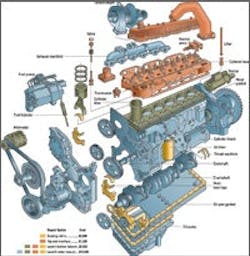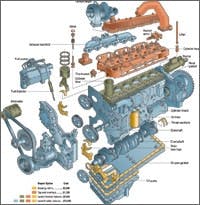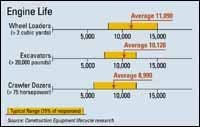Rx for Profit: Repair Before Failure
Little more than half of major-component repairs are done before something fails—actually 54 percent, according to Construction Equipment lifecycle research. It's a fact that is perplexing because fluid analysis and regular inspections provide the information needed to anticipate most failures, and repairing before breakdowns is clearly the most profitable way to use machines longer than their original component lives.
There are two likely reasons components are worked to failure. First, managers intent on squeezing every hour of useful life out of the iron are reluctant to throw away some working parts in order to schedule repairs when they are convenient. But parts savings alone are enough to prove that you don't have to gamble with tens of hours, or even hundreds of hours, to save money repairing before failure. The other reason is that equipment decision-makers don't get the information they need to know when components are showing symptoms of impending failure. The value of reduced downtime should motivate equipment users to tell you when it's time to schedule repairs before machines break.
Expensive, long-life parts are often damaged when a sacrificial part breaks. Piston rings, liners and valves, for instance, should last as long as two sets of engine main bearings. Clutch plates and discs, a hydraulic pump's pistons and swash plates, and final-drive shafts and gears are all expensive, reusable parts that can be lost when seals and bearings fail.
A major repair can save money even if it's done 1,000 hours before a component would have broken down. For example, suppose a machine's engine is showing signs of needing an overhaul at 8,000 hours. If you do an in-frame overhaul (replacing bearings, cylinder packs, fuel injectors, and reconditioning the head) right away, you spend about $5,500. Hourly cost for the engine work is 68 cents. If you squeeze in another 1,000 hours before the rebuild, repair cost drops to 61 cents per hour. But if the engine clunks and quits at 8,999 hours, it's going to cost somewhere in the neighborhood of $13,000 to rebuild. Hourly cost leaps to $1.44. You gambled to reduce engine costs by 7 cents per hour at the risk of losing 76 cents per hour. The extra 999 hours cost $7,500, or $7.50 per hour.
When you roll the repair-cost savings into a machine's total ownership and operating (O&O) costs, the advantages to repairing before failure remain clear. For example, repairing most drive-train components on a 165-hp bulldozer before they fail will cut the machine's total repair costs about 30 percent, allowing for an occasional component failure. At nine years old, the machine's O&O cost per hour will be about $1.50 less than the industry averages. At 12 years it will be more than $2 below the average, and slightly less than the O&O cost for the average seven-year-old machine. For every machine working 1,000 hours per year, that's a $2,000 annual savings, or $24,000 over its life.
If parts savings aren't convincing enough to galvanize corporate will to repair before failure, consider the downtime savings. Before failure, repairs can be scheduled around peak machine demand.
A 100-unit construction fleet that experiences 10 component failures—power trains, hydraulic pumps and motors, cylinders—every year produces an emergency phone call from an unhappy project manager about once each month of the construction season. That's 10 surprises, 10 suddenly unproductive operators and related crew, 10 extravagant expenditures on a hurry-up repair and/or a replacement machine. A company-wide commitment to scheduling repairs before failure can reasonably expect to reduce the number of expensive surprises to two or three.
The change calls for uniform corporate resolve to invest in preventive repairs. Fluid analysis and regular inspections provide the information necessary to anticipate failures. Completing the repairs takes some effort, costs some money, and demands a change in the way people look at repairs.
The larger the organization, the greater the investment in monitoring components. The information required to consistently repair components before failure is harder to gather and act upon in a larger company with a larger fleet. How well equipment-intensive businesses handle the challenge is a measure of how committed their managers are to keeping crews productive.
Establishing a range of expected life for various components will help manage repairs before failure. Construction Equipment lifecycle research shows some industry-average life expectations with this story and in our July story, Component Life Sketches Machine Economic Life. Equipment manufacturers, if pressed, can tell you the design life of their components. These numbers serve as basic guidelines, but operating conditions have so much impact on the actual life of equipment that some self-examination is necessary to make the most of your component investments.
Analyze your repair records to determine which components fail and how long they normally last. If the size of that task is daunting, tally up the total failures by component type to help set some priorities. If you never experience engine breakdowns, spend your analysis time determining how to prevent failed transmissions or hydraulic cylinders or some troublesome component.
Caterpillar recently developed a very useful tool that can help estimate specific life and cost expectations for various components and machines. It's a software tool called Site Operations and Maintenance Advisor (SOMA) that Cat dealers use to help customers analyze unique operations. This enhanced version of Cat's Overhaul Management Guide allows the dealer to modify average life expectations to match a particular operation based on load factors and the quality of maintenance and operating practices.
The user inputs how much of the time a machine is operated at severe, medium and light loads, and the system attaches a model-specific fuel-consumption rate to each of those severity levels. When load factors are entered, SOMA displays an optimum component-life estimate.
Then the customer rates general operating factors such as maintenance practices, operating practices, and site conditions on a five-point scale (excellent, good, average, fair, minimal). They also rate component-specific factors that, on an engine for instance, include lubricants, coolant, filters, fuel, contamination control, and condition monitoring. Any rating less than "excellent" reduces expected component life. If all other factors are "excellent," for example, but maintenance practices are rated "average," expected engine life for a Cat 320C excavator is reduced by about 10 percent.
Use the range of hours in which components fail to establish intervals for inspecting machines. As components approach the typical life range, watch their performance and fluid analysis more closely. Machines might even be brought down for thorough inspection at opportune moments, including analyzing the wear trends charted by oil sampling and comparing lab information to operating clues.
Every machine wears at a unique rate, based on operating and maintenance conditions, so managers have to watch oil analysis throughout a machine's whole life in order to consistently predict failures. You're not necessarily looking for absolute values of iron or chrome or other wear metals, but significant changes in two or more wear contaminants.
Lubricants from transmissions, differentials, final drives and hydraulic components can be analyzed and used to indicate life nearly as effectively as engine oil. And because controlling temperature has a dramatic effect on most components' lives, coolant analysis can play a significant role in preventing failures. An oil-analysis vendor that takes the time to understand your applications and operating conditions can be an important ally.
Another powerful technology for anticipating component failures is electronic. Computer monitoring systems showing up on all kinds of machines (thanks to electronic fuel injection needed for emissions control) monitor performance and record each time the cooling system overheated, each time an engine or a gear in a transmission ran faster than its rated speed, and anomalies in oil pressures, flows and temperatures.
Electronic monitoring systems can track hours of machine use. They can also track gallons of fuel burned, which is considered by many to be a more realistic measure of the amount of work a machine's components have done. Accurate, dependable accounting of how much machines work allows them to be repaired before failure more consistently, closer to the actual point of failure. Systems that report their information wirelessly, such as Caterpillar's ProductLink or Qualcomm's GlobalTRACS, put the information at the equipment decision makers' fingertips, bridging the sometimes vast gulf between users in the field and the shop.
With on-board computers recording every time any machine system is worked beyond its recommended performance parameters, there's never been an easier time to repair components before failure. Use the information to adjust maintenance, life expectations, and operator training. Components will last longer, and when repaired before failure, they will cost remarkably less to operate.






